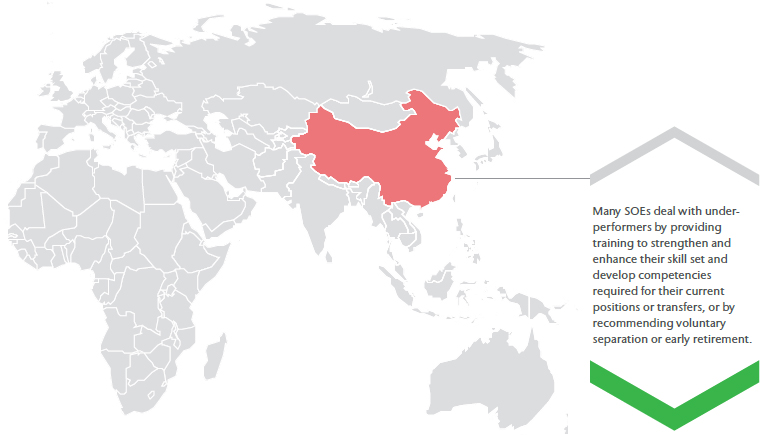
Navigating Through Human Resources Reform for China’s State-Owned Enterprises (SOEs)
Chinese State-Owned Enterprises have started undergoing extensive reforms as a result of increasing competition. With a focus on people, Human Resources reform (HR) is seen to be a more critical area as compared to other reforms. Hence, these SOEs are now challenged by their existing compensation systems, lifetime employment approach, as well as governance structure.
Globalization and an increasingly competitive environment have caused SOEs in China to undergo extensive reforms. In recent years, Chinese SOE reforms have looked in-depth into areas such as management process and organizational structure. Efforts are underway, especially in public financing, corporate mergers and acquisitions, and governance structure optimization.
Among all these areas, people and people process are the most critical and thus Human Resources (HR) reform is assuming greater significance in SOEs. The special status that Chinese SOEs enjoy in society and culture transcends the business environment, and has thus made people reform a challenge. Some of the important HR challenges occurring during SOE reforms in China are discussed below:
1. Compensation system – Design by seniority or by performance
Employees with a longer tenure in SOEs are usually better placed in their compensation, as compared to newer colleagues. These long-serving employees can receive higher salary and better welfare despite performing similar work as their new counterparts. They also may be given priority on opportunities for internal promotions. In SOEs, tenure and loyalty are deeply rooted in the organization.
From management’s perspective, a tenure-based compensation system is an effective method to minimize controversy and discontent among corporate employees. Some SOEs that are less likely to reform have expressed concern that any reform may bring negative outcomes. For example, senior employees worry that their authority may be weakened. Additionally, with longer-serving employees deemed more trustworthy (based on their proven loyalty and stability), this could be discouraging for high-performing, new employees.
This seniority-based compensation system in SOEs could prove to provide inadequate support for new employees’ ambitions – leading to high-performing new talent looking externally to advance their careers. Consequently, SOEs will not be able to capitalize on their people investment.
Some SOEs have realized this and are now taking necessary steps. Performance management is becoming a trend as seen by the increasing adoption of job analysis, job evaluation, and the setting of specific key performance indicators. These lead to more well defined jobs for incumbents.
Meanwhile, the resistance of tenured employees should be handled appropriately and sensitively. Through good communication, HR can assist tenured employees to recognize the merits and rationale of a performance management system in China’s increasingly competitive business environment.
2. Lifetime employment – How to deal with underperforming workers
As a result of an employment system providing a high degree of social welfare and social stability in the planned economy period, HR policies of SOEs are still attached to the concept of ‘lifetime employment’. It is not uncommon to find three generations from the same family working for the same company. With an undefined exit process for non-performers, SOEs will have to deal with talent shortages and redundancy.
To counter this, many SOEs deal with under-performers by providing training to strengthen and enhance their skill set and develop competencies required for their current positions or transfers, or by recommending voluntary separation or early retirement.

With this, some incumbent employees become more competitive when faced with a possible exit scenario from the company. However, significant layoffs from SOEs will create social tension, such as an increase in the unemployment rate and in government welfare, etc. Layoffs shall be made based on business needs and the performance of employees. Mindful linkage and setting meaningful key performance indicators are crucial. Communication is also a key success in this process.
3. Governance structure – Involve executives’ commitment
A general approach in SOE reform is an improvement of their governance structure. Special efforts have been in place to examine the corporate leadership team – especially the roles of the chairman, general manager, and party secretary.
SOE leaders tend to play the dual roles of businessmen as well as government officials. Besides considering economic benefits and growth, they also have to consider political stability and harmony within the community they lead. On the other hand, being overly concerned about the latter will inevitably weaken executives’ commitment towards people changes.
Prioritizing stability across the company would weaken any transformational effort. Faced with dramatic external forces, such as strong competition, weak financial performances, and declining industries, SOEs will be encouraged to increase the speed of HR reform.
Despite all these challenges, many SOEs have successfully executed HR reform. Management of the HR function no longer remains a domain for the HR department only. It requires executives and managers to consider HR at a strategic level and assume responsibilities at all levels. In fact, SOE leaders are aware that modern HR management must obtain strong support from corporate executives and employees.
With the increased emphasis on globalization, the new challenge facing SOEs is how to manage growth better and effectively integrate acquired subsidiaries, along with their people and processes, into a truly global company. To promote HR reform, SOEs can consider setting key performance indicators linked to business drivers. Meanwhile, succession planning and job rotation can also help. This will continue to be a long journey, and effective HR practices can lead to the success of SOEs’ reforms in China.
Author
Michele Lee
Head of Greater China
Aon Strategic Advisors & Transaction Solutions
[email protected]
Follow us on LinkedIn & Twitter
Get in touch
